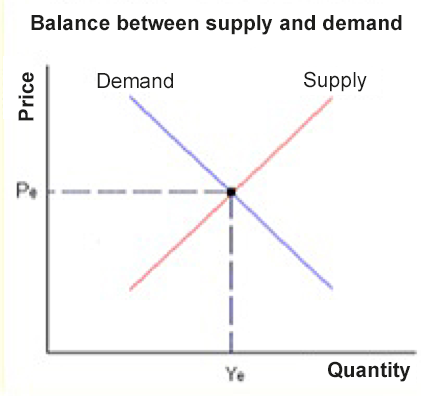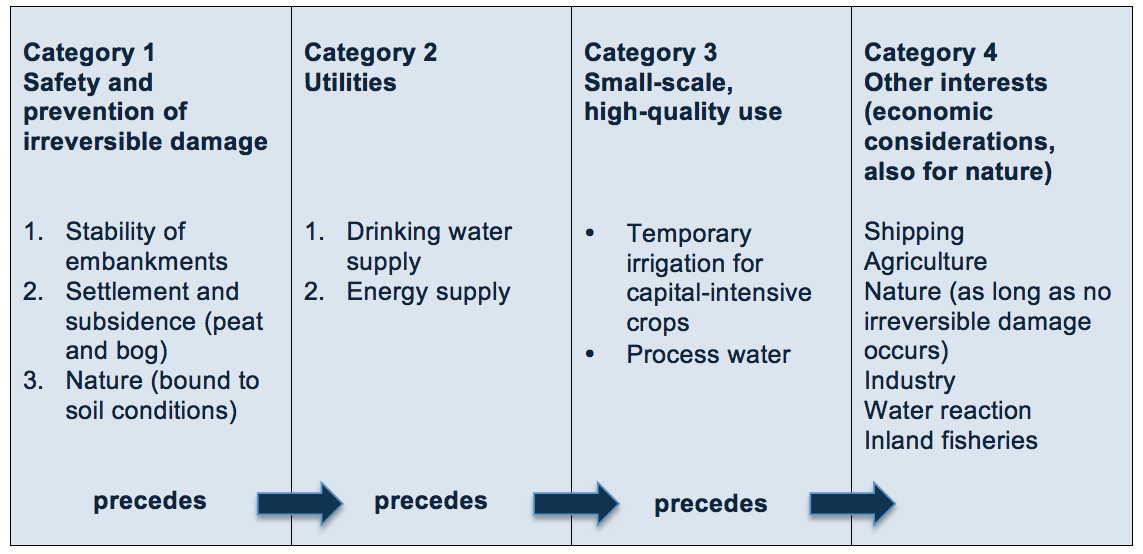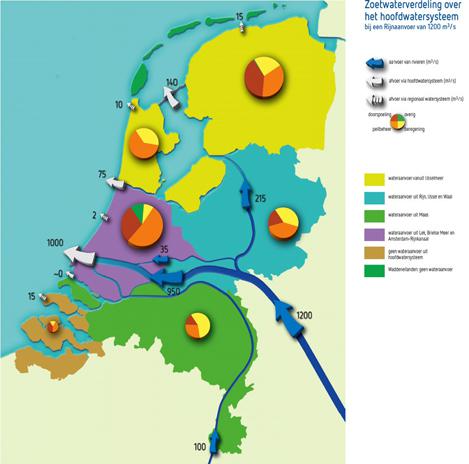Pricing of water for agriculture
This fact sheet provides the background on and strategies for pricing water – specifically surface water - used by agriculture for irrigation and the feasibility of pricing water for scarcity.
|
Thema |
Zoetwatervoorziening, Delta facts, English versions |
|
Tags |
|
|
Downloads |
- INTRODUCTION
- RELATED TOPICS AND DELTA FACTS
- STRATEGY
- PERFORMANCE
- FIELD EXPERIENCE (NATIONAL AND INTERNATIONAL)
- GOVERNANCE
- PRICING FEASIBILITY
Introduction

This fact sheet provides the background on and strategies for pricing water – specifically surface water - used by agriculture for irrigation and the feasibility of pricing water for scarcity.
Water pricing is proposed by various parties as a tool to make the Netherlands more climate-resilient (e.g. National Water Plan, 2009-2015; Stowa, 2010; Hoekstra, 2009). The contribution to better climate resilience is based on the assumption that pricing will achieve the dual objectives of higher water-use efficiency and lower water demand. An obviously desirable scenario, especially in light of forecasts that climate change will affect the balance between fresh water demand and availability, and thus fresh water river discharges, during prolonged dry periods.
With fresh water scarcity becoming an ever-growing issue, and the European Water Framework Directive doing little to address this concern, the European Commission set to work on a Blueprint that seeks to protect Europe’s water resources. The Blueprint, published in late 2012, suggests that water should not be regarded as a free good and that the current price of water does not reflect the actual cost, value or scarcity. To that end, the Blueprint defines, describes and analyses criteria for pricing water.
Related topics and Delta Facts
Topics: water shortage and fresh water supply, irrigation, level management, flushing, drought damage, salt damage, social costs, ecosystem services
Delta facts: Soil moisture-based irrigation; Effects of climate change on agriculture; Effectiveness of water intake; Controlled drainage; Company water reservoirs; Salt-tolerant crops
Strategy
Strategy: hold, store, supply
Water pricing is a strategy designed to encourage more efficient use of water (resources) and thus falls under the water supply strategy.
Performance
The pricing mechanism (Figure) achieves a balance between supply and demand for an

economic good, while ensuring that economic goods are used efficiently: inefficient producers will not be able to hold their own against the high cost price. Water pricing is therefore seen as a means to stimulate more efficient use of water resources. A balance between supply and demand can be achieved if the following four criteria are met. Water resources for irrigation fail to meet these four criteria in every respect:
- Homogenous good
Water is not a homogenous good. The quality of water varies both by location and time. The variation in quality is greatest in polders in Dutch lowlands due, among other things, to variability in saline seepage, and the intensity and effectiveness of flushing. Moreover, the security of supply also differs by location and time, both in terms of quantity and quality. - Market is transparent
The water market is not transparent. There are large differences in the pricing of ground and surface water, and even larger differences in regulations, permits and levies for groundwater extraction (Stoof & Ritsema, 2006). In polder regions the situation is even less transparent, because in those regions water is let in not only for irrigation purposes, but also for maintaining water levels in order to ensure the stability of dikes, buildings and other infrastructure. Rather than the usual “pay per water unit” system, there is instead an ’undeveloped water system levy‘ in place. The rates vary significantly from water board to water board (Table 1). - Large number of customers and suppliers
In many cases there is only one supplier of water for irrigation: the water board. Currently, private water suppliers like Evides, which has an agricultural water line in Zuid-Beveland, are an exception. - Market is easily accessible
The water market is quite accessible. The facts are the same as in 3.
| Delfland water board | € 137.51/ha |
| Hollandse Delta water board | € 79.73/ha |
| Zeeuwse Eilanden water board | € 59.71/ha |
| Zeeuws Vlaanderen water board | € 62.76/ha |
| Brabantse Delta water board | € 31.19/ha |
Table 1. ‘Undeveloped water system levy ’ by various water boards (De Vries, et al., 2009)One aspect that is often overlooked is that the supply and demand function for water is largely weather-driven. Unlike regular goods, the suppliers have very little control over the quantity of water they may supply. In other words, there is actually no supply function in the economic sense: supply has little or nothing to do with the price.
Field experience (national and international)
There is considerable international experience to draw on in pricing water. Water for irrigation, for example, is priced (Molle & Berkoff, 2007). The World Bank has long called for a system that would require users to pay for use of irrigation water resources. Initially, with the intention to recover the incurred costs from the users, but this effort proved only moderately successful. Since early 1990, the irrigation sector has been facing growing criticism over its overwhelming share of water use globally (70-80%), the generally low irrigation efficiency (40% on average), and the low return on investments. All of which led to formulation of the ‘Dublin Principles’ at the international water conference on water and the environment' in 1992. The fourth and final principle provides that water has an economic value in all its uses and should be regarded as an economic good. Following in the footsteps of Dublin, the World Bank has also come to regard pricing of irrigation water as a means to reduce demand for irrigation water (demand management).
Regarding water as an economic good does not mean that water should always come with a price tag, but it does imply that the value of water in its various uses should be defined to facilitate decision-making on water (Savenije, 2002). Study on the economic value of irrigation water in an Indian catchment basin (Musi) shows that the value of irrigation water use not only varies by crop, but also by region and season, and that the farmers price the use of water differently (Hellegers and Davidson, 2010).
Pricing ecosystems has garnered significant international attention. Linderhof et al. (2009) studied the options and consequences of mechanisms for payments for ecosystem services (PES) in the Dutch water policy based on such aspects as suitability, purpose, effectiveness and efficiency. They conclude that the government should assert its role as intermediary because ecosystem services often have a public nature. The use of competitive mechanisms, where different suppliers offer a number of ecosystem services for a certain price, is an attractive option for creating cost-effective water supply arrangements.
Governance
For extraction of (ground) water, specific rules are set forth in provincial environmental regulations and in the Bylaws of the water boards. These rules apply to the notification, registration and licensing obligation. Depending on the type of obligation, a relatively low fee – in the way of levies must be paid to the water board for extraction of surface water for irrigation purposes. However, not all water boards apply such levy systems. Farmers who extract groundwater incur costs associated with levies, publication and provincial levies. Because the levies are payable per m3 of extracted water, the incurred costs are much higher than the costs associated with the use of surface water. The province of Brabant, for example, charges € 0.19 per m3 of groundwater extracted if more than 10 m3 of water is pumped up per hour. Irrigation wells typically have a much larger pumping capacity.
During periods of water shortage, distribution of the available water in the national waters is determined according to the National Priority List. Distribution of regional waters is subject to regional priority lists that are based on the national list. Agriculture is low on the list of priorities.

In the event of looming water shortage, prioritised measures are taken to provide flood protection (stability of peat dikes, maintaining water levels) and to prevent irreversible damage to soil, drinking water and energy resources. To safeguard these interests, the water boards may supply fresh water or let in brackish water via alternative routes in order to maintain the water levels in areas with peat dikes. Provinces also have the option to establish regional priority lists within categories 3 and 4 or enter into regional water agreements. Both are established for different regions and implemented within the capabilities of the water system (2012).

In the Delta Programme different strategies are explored to identify practices that achieve sustainable fresh water supply in the long term. The need for this exploration stems from the realisation that the current system, management and policy are reaching their limits as climate change continues to go unchecked, causing more extreme and more frequent weather events. Solutions to more efficient use of water (resources) are also explored.
Pricing feasibility
The main criterion for pricing surface water for irrigation is to clearly identify all costs associated with supplying water for irrigation. In other words, effective water pricing depends on the ability to measure the water consumption of individual users. In the case of irrigation by groundwater this can be relatively easy to achieve by mandating the use of a water meter (or a calibrated KWh meter). The same is also possible for irrigation by surface water, although this is more difficult to monitor due to the mobile nature of the irrigation machines.
Pricing is difficult to pin down in polders because only a small quantity of the intake water is actually used for irrigation; a much larger quantity is used for level maintenance and flushing. Because flushing is largely carried out to keep the surface water fresh for irrigation, it can be used as an argument to allocate flushing costs proportionally to the irrigation volume per user. The counterargument, however, is that the desired water quality and thus the required flushing volume vary from crop to crop and the period in the growing season.
The Dutch water systems were originally designed for water drainage and level control, but have since also been used to supply water when and where it is needed during periods of scarcity. But because the purpose of the functional design did not include being a supply system, the supplying efficiency is generally low. In the polder regions with saline seepage, the efficiency is even lower due to flushing. In some areas, more than 20 times as much water is let in for flushing than is required for irrigation (Dijkhuis 2009). Here, the efficiency in the part of the system managed by the water boards is therefore very low compared to the efficiency at company level. Converting these systems into effective and efficient water supply systems will involve significant costs, and considerable modifications will be required to allow for the monitoring, registration and administration of the quantity and quality of water delivered.
Current (international) literature on pricing of irrigation water is based on the situation where the bulk of the crop water requirement is met through irrigation. This is fundamentally different from the situation in the Netherlands, where the share of the artificial application of water (= irrigation) to land is small in relation to natural rainfall. In fact, the amount and general reliability of rainfall in the summertime sometimes renders irrigation unnecessary. In the Dutch lowlands, the water-holding capacity of the soil, plus the upward water movement by capillary rise from the groundwater to the root zone is usually enough for crops to survive several weeks of dry spells without significantly compromising the yield. The situation becomes acute when the weather gets so hot and dry that the capillary rise is unable to keep up with rate of evaporation or its action ceases when the groundwater level drops below the capillary rise range. In such cases, the availability of a relatively small quantity of irrigation water can help prevent significant yield reduction, and the user will likely not care how much a cubic meter of water costs, given that the benefits - in terms of avoided damage per cubic meter of irrigation water - far outweigh the costs. Thus, pricing irrigation water is unlikely to reduce national demand significantly. For capital-intensive crops where water supply is heavily regulated, local pricing by water boards or private supplier may well be effective.

 English resume
English resume